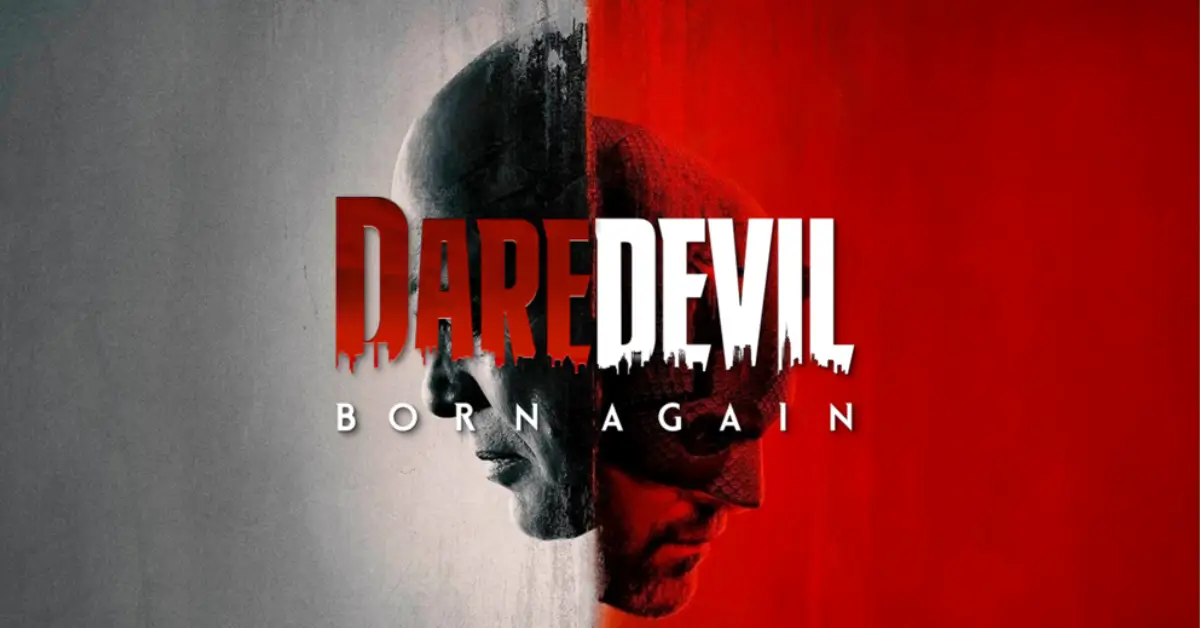Daredevil Born Again – When Darkness Becomes the Path to Mental Health and Redemption
In the evolving landscape of superhero storytelling, few characters embody the complex intersection of trauma, mental health, and resilience quite like Matt Murdock. Disney+’s revival of “Daredevil Born Again” offers viewers not just another entry in the Marvel canon, but a nuanced exploration of psychological struggle, personal identity, and the complicated journey toward healing. This darker, more mature series demonstrates how superhero narratives can serve as powerful vehicles for examining mental health themes that resonate far beyond their fantastical settings.
Thank you for reading this post, don't forget to subscribe!Basic Film Information
Title: Daredevil: Born Again
Release Date & Production Year: March 4, 2025 (two-episode premiere)
Directors: Multiple directors across the season, with a creative approach that honors the gritty, character-driven style established in the original Netflix series
Screenwriters: A team of writers following a creative overhaul that shifted the series toward a more serialized narrative structure
Main Cast & Characters:
- Charlie Cox as Matt Murdock/Daredevil: A blind lawyer with enhanced senses who struggles with his dual identity as a vigilante
- Vincent D’Onofrio as Wilson Fisk/Kingpin: Former crime lord now serving as New York City’s mayor
- Deborah Ann Woll as Karen Page: Journalist with a complicated history and relationship with Matt
- Elden Henson as Foggy Nelson: Matt’s best friend and law partner
- Jon Bernthal as Frank Castle/Punisher: A vigilante with a lethal approach to justice
- Wilson Bethel as Benjamin “Dex” Poindexter/Bullseye: A precision-skilled antagonist with severe mental instability
- Margarita Levieva as Heather Glenn: A new character in Matt’s orbit
- Ayelet Zurer as Vanessa Fisk: Wilson Fisk’s wife and moral compass
- Michael Gandolfini as Daniel Blake: A new character whose role intersects with the main narrative
Genre: Superhero drama, Crime thriller, Psychological drama
Awards: None yet, though the original Netflix series won multiple Emmy nominations
Runtime & Rating: Nine episodes in Season 1 (TV-MA equivalent for mature themes, violence, and psychological content)
Plot Summary
“Daredevil Born Again” picks up the narrative thread several years after the conclusion of the original Netflix series, finding Matt Murdock in a particularly vulnerable psychological state. Having abandoned his Daredevil persona for approximately a year, Matt has attempted to live solely as a lawyer, suppressing the vigilante identity that had previously provided him with purpose and a channel for his trauma responses.
The central mental health theme emerges immediately: Matt’s attempt to deny a core aspect of himself has led not to healing but to deeper psychological distress. His withdrawal from vigilantism represents a common but often ineffective coping mechanism avoidance which mental health professionals recognize rarely resolves underlying trauma.
Meanwhile, Wilson Fisk has undergone his own transformation, achieving legitimacy by being elected mayor of New York City. This external validation of a character viewers know to be morally compromised creates a fascinating exploration of societal versus personal definitions of goodness and worth a theme that resonates strongly with those struggling with self-image and identity.
The series explores how Matt’s Catholic guilt, childhood trauma, and sensory differences (both his blindness and enhanced perceptions) shape his mental landscape. His eventual return to the Daredevil identity isn’t portrayed simply as a hero’s return but as a complex psychological reckoning an acknowledgment that integrating rather than suppressing parts of oneself may be necessary for genuine healing.
Key turning points in the narrative highlight moments where characters must confront their deepest fears, traumas, and self-deceptions. The return of Bullseye (Wilson Bethel) is particularly significant, as this character serves as a dark mirror to Matt someone whose mental instability manifests in violence without the moral framework Matt has developed.
Setting & Cinematic Techniques
Filmed on location in New York City, “Daredevil Born Again” uses the urban landscape not merely as backdrop but as visual metaphor for its characters’ psychological states. Dark alleys, imposing architecture, and the contrast between Hell’s Kitchen’s gritty streets and the gleaming offices of power create a visual language that reinforces the series’ themes of duality and internal conflict.
Cinematographers Hillary Fyfe Spera and Pedro Gómez Millán bring distinctive visual approaches that highlight the characters’ psychological experiences. Scenes featuring Matt often employ subjective camera techniques that approximate his unique sensory perception, immersing viewers in his experience of the world. This approach creates empathy for neurological differences while underscoring how Matt’s heightened senses can be both gift and burden similar to how many mental health conditions create both challenges and unique perspectives.
The series’ color palette shifts subtly with characters’ emotional states, moving from muted, desaturated tones during moments of depression or disconnection to more intense, vibrant colors during periods of psychological integration or clarity. This visual storytelling reinforces the mental health narrative without relying on exposition.
The Newton Brothers’ score incorporates motifs from the original series while introducing new elements that track the characters’ psychological journeys. Music becomes particularly effective in scenes depicting Matt’s sensory overwhelm or emotional breakthroughs, using audio cues to place viewers inside his subjective experience.
Acting & Character Portrayal
Charlie Cox’s portrayal of Matt Murdock/Daredevil continues to be the emotional anchor of the series. His performance navigates the complex territory of a character who experiences what could be described as functional depression someone who can fulfill professional obligations while suffering profound internal distress. Cox’s subtle physical performance conveys Matt’s hypervigilance, a common symptom for those with trauma histories, through constant awareness of his surroundings even in seemingly safe environments.
Vincent D’Onofrio brings nuanced complexity to Wilson Fisk, portraying him not as a cartoonish villain but as someone whose moral compromises stem from his own traumatic background. His character’s need for control and power can be understood through a mental health lens as maladaptive responses to childhood helplessness destructive coping mechanisms that have calcified into a dangerous personality structure.
Wilson Bethel’s return as Bullseye provides the series with its most explicit portrayal of mental illness. The character’s antisocial tendencies and obsessive fixations are depicted not simply as “madness” but as the result of neurological differences and traumatic experiences that have gone untreated. While the portrayal necessarily operates within genre conventions, it attempts to humanize rather than demonize mental instability.
Mental Health Representation: Strengths & Weaknesses
“Daredevil: Born Again” addresses several mental health conditions and psychological states with varying degrees of nuance:
- Post-traumatic stress: Matt’s hypervigilance, flashbacks to childhood trauma, and difficulty forming intimate connections align with clinical understanding of PTSD. The series portrays recovery not as a linear process but as a complex journey with setbacks and breakthroughs.
- Depression: Several characters exhibit symptoms consistent with depression, including withdrawal from previously meaningful activities, sleep disturbances, and fluctuations in motivation. These portrayals avoid simplistic “sadness” stereotypes in favor of depicting the complex reality of functioning while depressed.
- Moral injury: Matt’s Catholic background frames his psychological struggles in terms of guilt and redemption, exploring how perceived moral failures can create profound psychological wounds distinct from trauma.
- Antisocial personality traits: Through characters like Bullseye, the series examines the roots of antisocial behavior without excusing harmful actions.
The series’ greatest strengths lie in its willingness to present mental health challenges as ongoing processes rather than problems to be “solved.” Characters don’t magically recover but learn to integrate their experiences and develop healthier coping mechanisms a much more realistic portrayal than many media depictions.
However, the superhero genre’s requirements sometimes limit how realistically these conditions can be portrayed. The show occasionally falls into the trap of using mental illness as a motivator for villainy, particularly with secondary antagonists. While the writing attempts to humanize these characters, the format sometimes reinforces problematic associations between mental illness and violence.
Without confirmation that mental health consultants were involved in production, questions remain about the clinical accuracy of some portrayals. The show walks a delicate line between using mental health themes for dramatic depth and potentially misrepresenting complex psychological conditions.
Critical Reception & Audience Response
With a 87% approval rating on Rotten Tomatoes, critics have largely praised “Daredevil: Born Again” for its mature approach to both character development and mental health themes. Many reviews specifically highlight the show’s willingness to explore psychological complexity within the superhero genre, noting that the series treats its characters’ mental struggles with the same seriousness as their physical battles.
Audiences have responded positively to the psychological depth, with the series garnering 7.5 million views in its first five days marking Disney+’s biggest premiere of 2025 up to that point. This commercial success suggests growing audience appetite for superhero content that engages meaningfully with mental health themes rather than using them as shallow character quirks.
Mental health professionals and advocates have offered mixed but generally positive responses. Some praise the series for normalizing the ongoing nature of mental health challenges, while others express concern about the occasional reinforcement of stereotypes linking mental illness with violence or moral compromise.
Cultural & Social Impact
“Daredevil: Born Again” arrives at a cultural moment when discussions about mental health have become increasingly mainstream. By featuring characters whose superhuman abilities exist alongside very human psychological struggles, the series contributes to normalizing conversations about mental health.
The show’s portrayal of a protagonist who continues to function professionally while battling inner demons resonates with many viewers’ experiences of high-functioning anxiety or depression. This representation helps challenge simplistic media narratives about what mental health challenges “look like,” acknowledging that many people navigate these conditions while fulfilling demanding roles.
For the superhero genre specifically, “Daredevil: Born Again” represents continued evolution toward psychological complexity. Building on the mental health themes explored in the original Netflix series and other Marvel properties like “Moon Knight” and “WandaVision,” this revival suggests superhero storytelling can meaningfully engage with serious psychological content while remaining accessible to mainstream audiences.
Personal Reflection & Final Thoughts
Based on its first season, “Daredevil: Born Again” offers viewers a superhero narrative that doesn’t shy away from the psychological toll of trauma. By centering characters who continue to struggle with their mental health rather than achieving neat resolution, the series creates space for more authentic discussions about the ongoing nature of psychological challenges.
For viewers who struggle with similar issues religious guilt, trauma recovery, sensory processing differences, or questions of identity seeing these themes explored through Matt Murdock’s journey may provide valuable representation, though the fantastical context necessarily limits how directly applicable these metaphors can be.
The series could strengthen its mental health portrayals by confirming consultation with psychological experts and being more explicit about its approach to these sensitive themes. Nevertheless, its willingness to engage seriously with characters’ inner lives rather than focusing exclusively on external conflicts marks a positive evolution in superhero storytelling.
Conclusion
“Daredevil: Born Again” demonstrates how superhero narratives can serve as powerful vehicles for exploring psychological themes that resonate far beyond their fantastical settings. Through Matt Murdock’s journey a man literally fighting his inner and outer demons viewers encounter a nuanced portrayal of how trauma shapes identity and how integration of one’s full self, rather than suppression of difficult aspects, often provides the path to healing.
The series suggests that true heroism lies not in the absence of psychological struggle but in continuing to fight for justice and connection despite these challenges. In a genre often defined by physical strength, “Daredevil: Born Again” presents a compelling case that emotional resilience the ability to face one’s darkest thoughts and feelings represents an equally powerful form of heroism.
As we anticipate the series’ continuation, perhaps its most valuable contribution is normalizing the idea that mental health journeys aren’t completed in a single season or a single lifetime. Recovery isn’t about reaching a perfect end state but about developing the tools to navigate ongoing challenges with greater self-awareness and healthier coping mechanisms. In this way, Matt Murdock’s journey mirrors our own: imperfect, ongoing, and worthy of compassion.
What do you think about how “Daredevil: Born Again” portrays mental health themes? Does seeing these struggles represented in superhero narratives help normalize conversations about psychological challenges? Share your perspective in the comments below.

